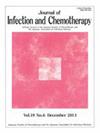基于肝功能障碍患者白蛋白-胆红素(ALBI)评分的人群药代动力学分析优选伏立康唑剂量。
IF 1.5
4区 医学
Q3 INFECTIOUS DISEASES
引用次数: 0
摘要
伏立康唑(Voriconazole, VRCZ)是一种抗真菌药物,用于治疗难治性真菌感染。其剂量根据个人肝功能调整。本研究旨在建立基于白蛋白-胆红素(albumin-bilirubin, ALBI)评分的人群药代动力学分析模型,仅以白蛋白和总胆红素水平为协变量,客观评价肝功能。方法:对2012 - 2022年间口服VRCZ治疗的16例肝功能障碍患者的126份血浆样本进行分析。采用Phoenix NLME软件进行群体药代动力学分析,并进行蒙特卡罗模拟,确定达到血液VRCZ目标浓度的最佳给药方案。结果:血VRCZ浓度采用带滞后时间的1室模型。在最终模型中,ALBI评分纳入清除率后,目标函数明显降低。蒙特卡罗模拟显示,ALBI评分为-3、-2和-1时,最佳给药方案分别为100mg每日两次、75mg每日两次和50mg每日两次。值得注意的是,对于ALBI评分为0的患者,即使每天两次50 mg的给药方案也超过了目标血液VRCZ浓度。结论:据我们所知,本研究首次将ALBI评分纳入VRCZ的人群药代动力学模型。我们的模拟结果表明,维持剂量应根据ALBI评分减少。此外,我们的研究结果强调了ALBI评分在最佳药物剂量设计中的潜在应用。本文章由计算机程序翻译,如有差异,请以英文原文为准。
Optimization of voriconazole dosage via population pharmacokinetic analysis based on the albumin–bilirubin (ALBI) score of patients with liver dysfunction
Introduction
Voriconazole (VRCZ) is an antifungal agent used to treat refractory fungal infections. Its dosage is adjusted based on the individual liver function. In this study, we aimed to establish a population pharmacokinetic analysis model based on the albumin–bilirubin (ALBI) score to objectively assess the liver function using only albumin and total bilirubin levels as covariates.
Methods
In total, 126 plasma samples of 16 patients with liver dysfunction who received oral VRCZ between 2012 and 2022 were analyzed in this study. Phoenix NLME software was used for population pharmacokinetic analysis, and Monte Carlo simulations were performed to determine the optimal dosing regimen to achieve the target blood VRCZ concentration.
Results
Blood VRCZ concentration was described using a one-compartment model with lag time. In the final model, objective function was significantly decreased upon ALBI score incorporation into clearance. Monte Carlo simulations showed that the optimal dosing schedules were 100 mg twice daily, 75 mg twice daily, and 50 mg twice daily for ALBI scores of −3, −2, and −1, respectively. Notably, for an ALBI score of 0, target blood VRCZ concentration was exceeded, even a dosing regimen of 50 mg twice daily.
Conclusion
To the best of our knowledge, this study is the first to incorporate the ALBI score into a population pharmacokinetic model for VRCZ. Our simulation results suggest that the maintenance dose should be reduced based on the ALBI score. Furthermore, our findings highlight the potential use of the ALBI score for optimal drug dosage design.
求助全文
通过发布文献求助,成功后即可免费获取论文全文。
去求助
来源期刊

Journal of Infection and Chemotherapy
INFECTIOUS DISEASES-PHARMACOLOGY & PHARMACY
CiteScore
4.10
自引率
4.50%
发文量
303
审稿时长
47 days
期刊介绍:
The Journal of Infection and Chemotherapy (JIC) — official journal of the Japanese Society of Chemotherapy and The Japanese Association for Infectious Diseases — welcomes original papers, laboratory or clinical, as well as case reports, notes, committee reports, surveillance and guidelines from all parts of the world on all aspects of chemotherapy, covering the pathogenesis, diagnosis, treatment, and control of infection, including treatment with anticancer drugs. Experimental studies on animal models and pharmacokinetics, and reports on epidemiology and clinical trials are particularly welcome.
 求助内容:
求助内容: 应助结果提醒方式:
应助结果提醒方式:


